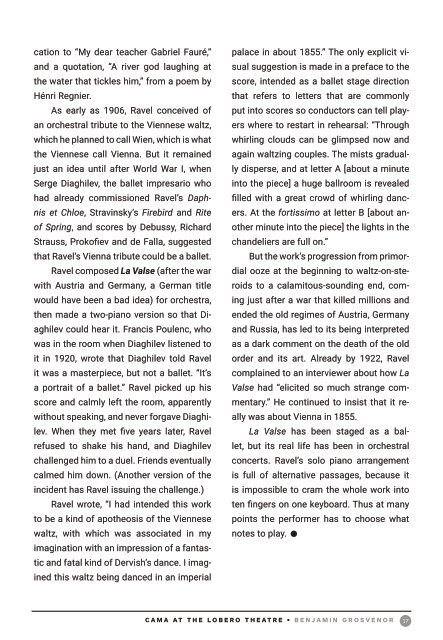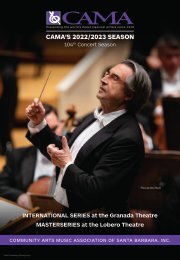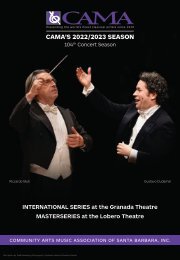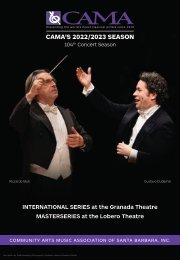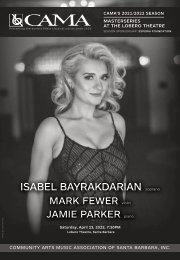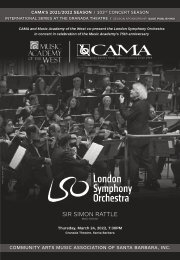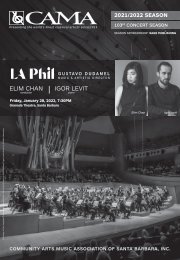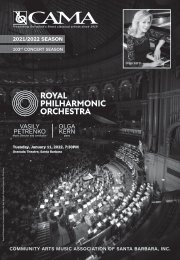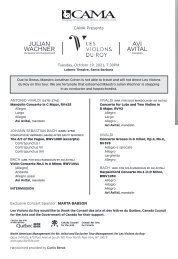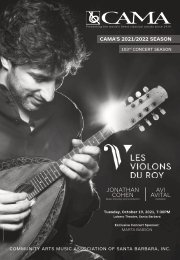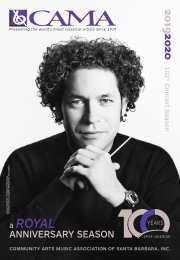CAMA's Masterseries Presents Benjamin Grosvenor, piano ⫽ Friday, March 18, 2022 ⫽ Lobero Theatre, Santa Barbara ⫽ 7:30PM
FRIDAY, MARCH 18, 2022, 7:30PM CAMA's Masterseries Presents BENJAMIN GROSVENOR, piano “His solo recitals recall an earlier generation of wizards of the piano.” —Financial Times British pianist Benjamin Grosvenor (b.1992) has been described as “the best pianist to come out of England in the last 50 years.” One only needs to listen to his playing to understand that the accolades are well deserved. Grosvenor’s promise was evident from a young age; he was the winner of the Keyboard Final of the 2004 BBC Young Musician Competition at the age of eleven, and was invited to perform with the BBC Symphony Orchestra at the Opening Night of the 2011 BBC Proms at London’s Royal Albert Hall at age nineteen. Turned away from performance by suddenly imposed pandemic precautions while already in Santa Barbara in March 2020, CAMA is delighted to welcome Benjamin Grosvenor back for his proper Santa Barbara and Masterseries debut! PROGRAM: FRANCK: Prélude, Chorale et Fugue, FWV 21 (1884) R. SCHUMANN: Kreisleriana, Op.16 ALBÉNIZ: Iberia, Book I RAVEL: Jeux d’eau RAVEL: La valse •
FRIDAY, MARCH 18, 2022, 7:30PM
CAMA's Masterseries Presents
BENJAMIN GROSVENOR, piano
“His solo recitals recall an earlier generation of wizards of the piano.” —Financial Times
British pianist Benjamin Grosvenor (b.1992) has been described as “the best pianist to come out of England in the last 50 years.” One only needs to listen to his playing to understand that the accolades are well deserved. Grosvenor’s promise was evident from a young age; he was the winner of the Keyboard Final of the 2004 BBC Young Musician Competition at the age of eleven, and was invited to perform with the BBC Symphony Orchestra at the Opening Night of the 2011 BBC Proms at London’s Royal Albert Hall at age nineteen. Turned away from performance by suddenly imposed pandemic precautions while already in Santa Barbara in March 2020, CAMA is delighted to welcome Benjamin Grosvenor back for his proper Santa Barbara and Masterseries debut!
PROGRAM:
FRANCK: Prélude, Chorale et Fugue, FWV 21 (1884)
R. SCHUMANN: Kreisleriana, Op.16
ALBÉNIZ: Iberia, Book I
RAVEL: Jeux d’eau
RAVEL: La valse
•
Create successful ePaper yourself
Turn your PDF publications into a flip-book with our unique Google optimized e-Paper software.
cation to “My dear teacher Gabriel Fauré,”<br />
and a quotation, “A river god laughing at<br />
the water that tickles him,” from a poem by<br />
Hénri Regnier.<br />
As early as 1906, Ravel conceived of<br />
an orchestral tribute to the Viennese waltz,<br />
which he planned to call Wien, which is what<br />
the Viennese call Vienna. But it remained<br />
just an idea until after World War I, when<br />
Serge Diaghilev, the ballet impresario who<br />
had already commissioned Ravel’s Daphnis<br />
et Chloe, Stravinsky’s Firebird and Rite<br />
of Spring, and scores by Debussy, Richard<br />
Strauss, Prokofiev and de Falla, suggested<br />
that Ravel’s Vienna tribute could be a ballet.<br />
Ravel composed La Valse (after the war<br />
with Austria and Germany, a German title<br />
would have been a bad idea) for orchestra,<br />
then made a two‐piano version so that Diaghilev<br />
could hear it. Francis Poulenc, who<br />
was in the room when Diaghilev listened to<br />
it in 1920, wrote that Diaghilev told Ravel<br />
it was a masterpiece, but not a ballet. “It’s<br />
a portrait of a ballet.” Ravel picked up his<br />
score and calmly left the room, apparently<br />
without speaking, and never forgave Diaghilev.<br />
When they met five years later, Ravel<br />
refused to shake his hand, and Diaghilev<br />
challenged him to a duel. Friends eventually<br />
calmed him down. (Another version of the<br />
incident has Ravel issuing the challenge.)<br />
Ravel wrote, “I had intended this work<br />
to be a kind of apotheosis of the Viennese<br />
waltz, with which was associated in my<br />
imagination with an impression of a fantastic<br />
and fatal kind of Dervish’s dance. I imagined<br />
this waltz being danced in an imperial<br />
palace in about 1855.” The only explicit visual<br />
suggestion is made in a preface to the<br />
score, intended as a ballet stage direction<br />
that refers to letters that are commonly<br />
put into scores so conductors can tell players<br />
where to restart in rehearsal: “Through<br />
whirling clouds can be glimpsed now and<br />
again waltzing couples. The mists gradually<br />
disperse, and at letter A [about a minute<br />
into the piece] a huge ballroom is revealed<br />
filled with a great crowd of whirling dancers.<br />
At the fortissimo at letter B [about another<br />
minute into the piece] the lights in the<br />
chandeliers are full on.”<br />
But the work’s progression from primordial<br />
ooze at the beginning to waltz‐on‐steroids<br />
to a calamitous‐sounding end, coming<br />
just after a war that killed millions and<br />
ended the old regimes of Austria, Germany<br />
and Russia, has led to its being interpreted<br />
as a dark comment on the death of the old<br />
order and its art. Already by 1922, Ravel<br />
complained to an interviewer about how La<br />
Valse had “elicited so much strange commentary.”<br />
He continued to insist that it really<br />
was about Vienna in 1855.<br />
La Valse has been staged as a ballet,<br />
but its real life has been in orchestral<br />
concerts. Ravel’s solo piano arrangement<br />
is full of alternative passages, because it<br />
is impossible to cram the whole work into<br />
ten fingers on one keyboard. Thus at many<br />
points the performer has to choose what<br />
notes to play.<br />
CAMA AT THE LOBERO THEATRE • BENJAMIN GROSVENOR<br />
17


